Confucius
Institute
The Mid-Autumn Festival: Celebrating the Mandala of the Sky
The 15th day of the 8th lunar month traditionally marks the Mid-Autumn Festival (Chinese: 中秋节; pinyin: zhōng qiū jié) in China which will fall on the 10th of September in 2022. The Mid-Autumn Festival is one of the most important festivals for Chinese people along with the Chinese New Year and the Dragon Boat Festival. Some East and Southeast Asian countries also celebrate the Mid-Autumn Festival.
Origins and legends
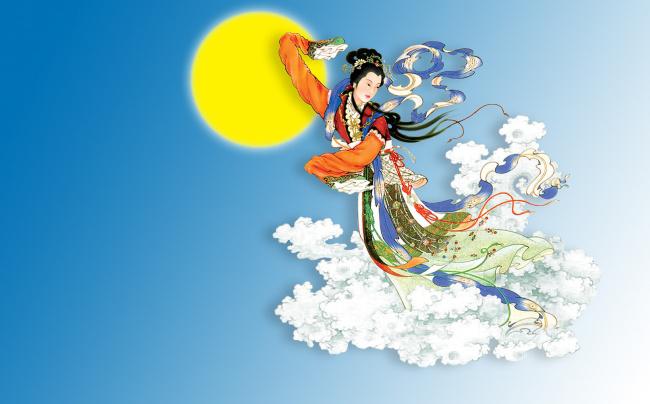
(Image sourced from 699pic.com – Chang’e)
The origin of the Mid-Autumn Festival might have started as early as 770 to 476 B.C or during the Zhou Dynasty (1045 to 425 B.C). To respect the Chinese kings who worshipped and offered sacrifices to the moon goddess, noble officials and wealthy merchants all chose to follow suit. The practice of moon-worship gradually evolved into festive gaiety to celebrate the full moon.
It is also widely believed that the festival was related to harvest celebration. The 8th lunar month in the northern hemisphere is the ripening season for crops and fruits. People would celebrate the harvest, express gratitude, and make wishes for a better life.
Ancient Chinese believed that the moon on this particular night was the roundest and the brightest throughout the year. The word of round (Chinese: 圆; pinyin: yuán) has multiple meanings in Chinese such as round in shape, satisfaction, and completion. The full moon signifies reunion and perfection.
However, the most intriguing legend related to this festival is about a story of love and betrayal. According to the legend in ancient times, there were ten suns in the sky. At a time when crops withered to death and people suffered, a hero named Hou Yi shot down nine suns with arrows and ordered the last one to rise and set regularly.
One day, Hou Yi obtained an elixir that could grant eternal youth - anyone taking it would ascend to heaven and become immortal. Hou Yi was reluctant to leave his beloved wife Chang'e (Chinese: 嫦娥; pinyin: cháng'é) so he did not take the elixir.
Unfortunately, Chang'e had a different idea and that she stealthily swallowed the elixir. Instantly, she was lifted to the air and flew to the moon. Hou Yi was distraught and constantly looked up to the night sky to search for his wife. One night, he found that the moon was exceptionally bright and in it a swaying figure that resembled Chang'e.
For generations, people wonder why Chang'e took the elixir - maybe staying young forever was too irresistible for a lady? Maybe she did not realize the consequence of the eternal separation from her husband? The scene of her flying to the moon has become the festival symbol and is often used for marketing such as greeting cards and moon cake boxes. China’s aerospace scientists named the spacecrafts after Chang'e in the Chinese Lunar Exploration Program, a project also known as the Chang'e Project.
Beautiful poems
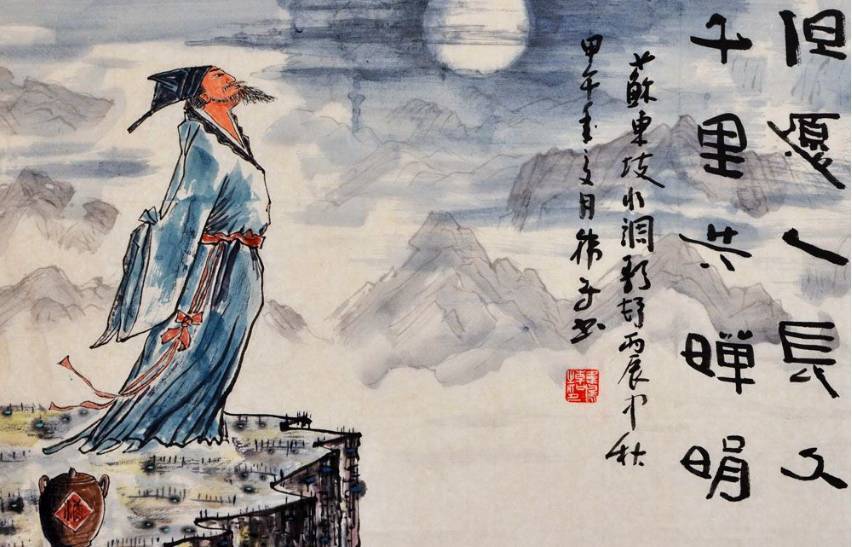
(Image sourced from https://inf.news/en/culture/d42fbce478479b8353118e7849c368ea.html)
The Mid-Autumn Festival has inspired many popular Chinese poems. Over all these thousands of years, verses and composition from the poems have added nostalgic, philosophical, and romantic aura to the moon and the festival. Here are some examples:
举头望明月 | I lift my eyes and see the moon, |
低头思故乡 | I lower my face and think of home. |
by Li Bai (701–762 AD) of Tang Dynasty (translated by Yang Xianyi and Dai Naidie: https://en.wikipedia.org/wiki/Li_Bai#Nostalgia), and
人有悲欢离合 | People experience sorrow, joy, separation, and reunion |
月有阴晴圆缺 | The moon maybe dim or bright, round or crescent shaped |
此事古难全 | This imperfection has been going on since the beginning of time |
但愿人长久 | May we all be blessed with longevity |
千里共婵娟 | Though thousands of miles apart, we are still able to share the beauty of the moon together |
by Su Shi (1037–1101 AD) of Song Dynasty (translation sourced from Wikipedia: https://en.wikipedia.org/wiki/Shuidiao_Getou )
About Moon Cakes
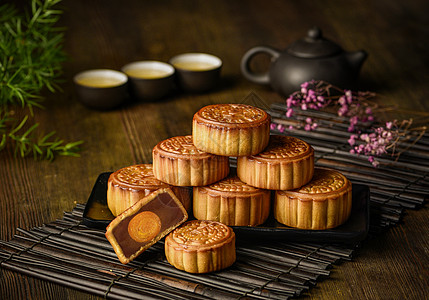
(Image sourced from 699pic.com – moon cakes)
There are many legends about the custom of eating moon cakes. Here is one of the stories: In the Yuan Dynasty (1271 to 1368 AD), people could not bear the cruelty of the Mongol empire and planned to rebel. Zhu Yuanzhang (1328-1398 AD), the leader of the uprising forces and subsequently the first emperor of the Ming Dynasty needed to notify his followers of the uprising date. It was an impossible task under the Mongols’ strict surveillance. One of Zhu’s assistants came up with an idea to pass the information by wrapping a note inside a pancake. The note read "Uprising on the night of the 15th August”. The filled pancakes were distributed to the rebels and the uprising succeeded. Zhu rewarded his followers with pancakes filled with delicious ingredients in the following Mid-Autumn Festival. Since then, the custom of having moon cakes has spread.
Today, people enjoy moon cakes along with seasonal fresh and dried fruits to celebrate reunion. Moon cakes are gifted to relatives and friends.
About Lanterns
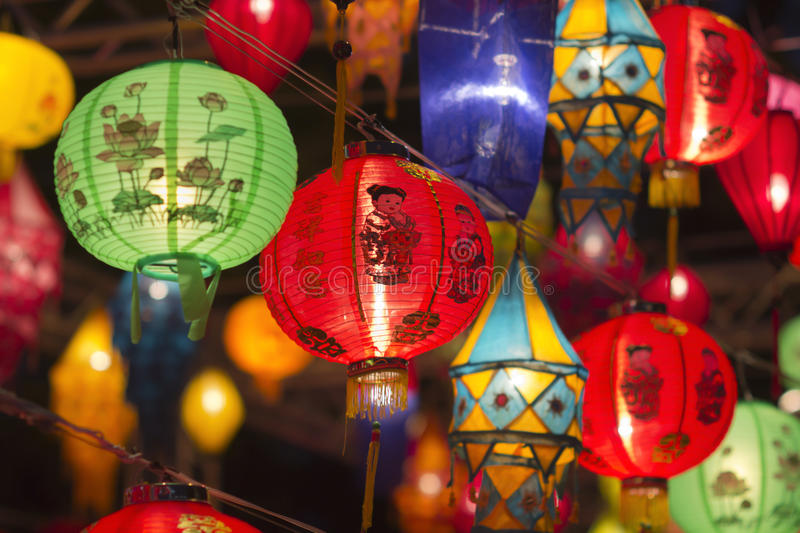
(Image sourced from Dreamstime.com – Lanterns)
Another representative custom for the Mid-Autumn Festival is lantern displays. Parents enjoy helping their children make lanterns that come in different varieties of colours and shapes. Lanterns are hung on the trees, houses, floated on the rivers. etc., during the festival. It is quite a spectacular sight! Young couples would also carry lanterns and spend time together for moon gazing.
Other Custom
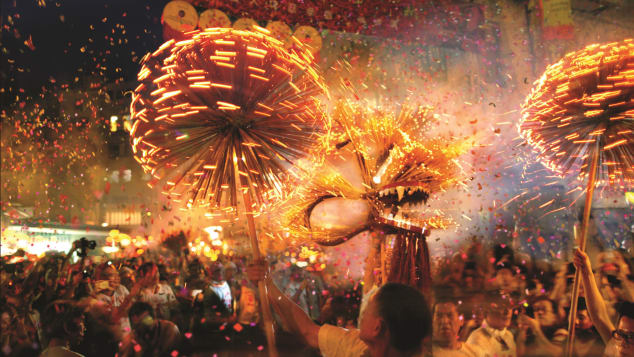
(Image courtesy of Hong Kong Tourism Board)
In Zhejiang province, strong tides are generated by the full moon and tide-watching during the festival has become an important activity. In the Chaoshan area of Canton, people provide their ancestors with food offerings. The fire dragon dance in Hong Kong’s village called "Tai Hang” has been listed in China’s National intangible Cultural Heritage since 2011. Lined with incense sticks from head to tail, the fire dragon as long as 70 meters is paraded by more than 300 people who would be happily dancing under the full moon.
The University of Newcastle acknowledges the traditional custodians of the lands within our footprint areas: Awabakal, Darkinjung, Biripai, Worimi, Wonnarua, and Eora Nations. We also pay respect to the wisdom of our Elders past and present.